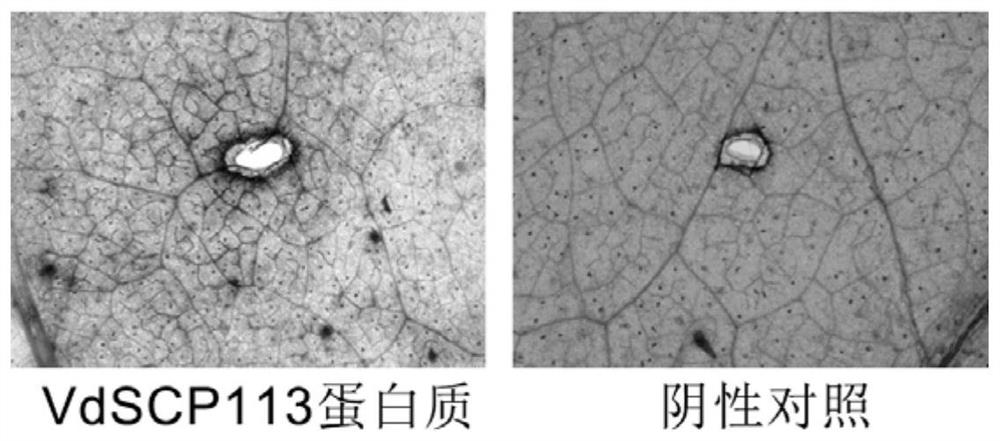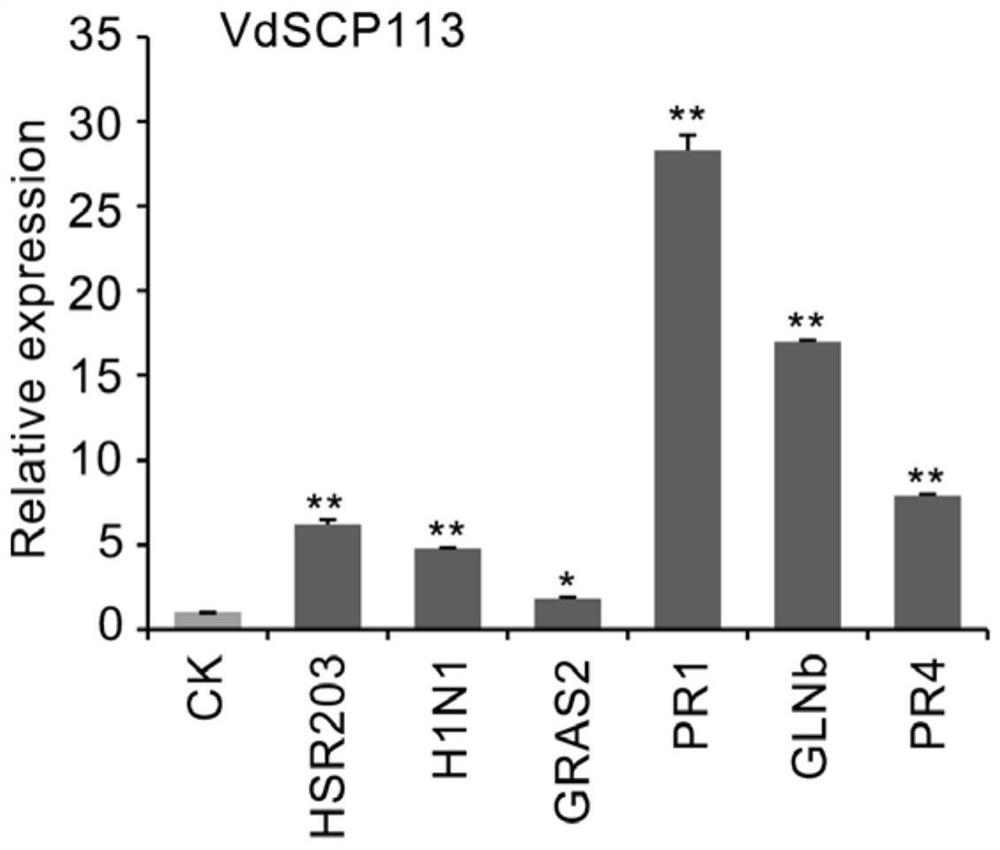Application of a kind of Verticillium dahliae effector protein vdscp113
A technology of Verticillium dahliae and effector protein, which can be used in application, fungicides, chemicals for biological control, etc., can solve the problems of low induction efficiency, etc., and achieve the effect of obvious induction effect and broad application prospects.
- Summary
- Abstract
- Description
- Claims
- Application Information
AI Technical Summary
Problems solved by technology
Method used
Image
Examples
Embodiment 1
[0050] Example 1 The Effector Protein VdSCP113 Stimulates Tobacco Immune Response
[0051] (1) Effector protein VdSCP113 induces ROS response in tobacco leaves
[0052] Using a 1 mL syringe without a needle, inject about 20 μL, 100 nM effector protein VdSCP113 into 3-4 week-old tobacco leaves from the back of the leaves. Tris-HCl (20 nM, pH 8.0) at the same concentration was used as a negative control. After 6 hours of injection, the treated tobacco leaves were rinsed with deionized water, placed in DAB dyeing solution, incubated at 25°C in the dark for 8 hours, the dyeing solution was removed and the dyed tobacco leaves were rinsed with deionized water, and then washed with Decolorize with 95% ethanol, observe and take pictures with a stereomicroscope.
[0053] Results: Tobacco leaves injected with the effector protein VdSCP113 had a large amount of H in the injected area 2 o 2 Accumulation of tobacco leaves injected with Tris-HCl, injection area H 2 o 2 The accumulatio...
Embodiment 2
[0063] Example 2 Effector protein VdSCP113 induces tobacco resistance to pathogenic bacteria
[0064] Using a 1 mL syringe without a needle, inject about 20 μL of 100 nM effector protein VdSCP113 into 4-week-old tobacco leaves from the back of the leaves. Tris-HCl (20 nM, pH 8.0) at the same concentration was used as a negative control. 12h-24h after injection, use a needle to pierce the injection area, and prepare 5 μL in advance, 5×10 6 The spores / mL spore suspension of different pathogenic bacteria to be tested was dropped directly above the eye of the needle, cultivated at 25°C and 80% humidity, and observed and measured the area of each lesion 3-5 days after inoculation. Experimental results such as Figure 4 shown. The inhibition of effector protein VdSCP113 on tobacco leaf lesions caused by various pathogenic bacteria is shown in Table 1.
[0065] Table 1 Inhibition of effector protein VdSCP113 on tobacco leaf lesions caused by various pathogenic bacteria
[0066...
Embodiment 3
[0068] Example 3 Effector protein VdSCP113 induces the resistance response of different plants to Botrytis cinerea
[0069] The effector protein VdSCP113 solution with a concentration of about 100nM was used to spray or root-irrigate the plants of different experimental groups. Each group of experimental leaves was sprayed with 1-2mL or the roots were irrigated with 10-15mL of the above-mentioned protein solution. The number of plants used in the experiment was 20. Tris-HCl (20 nM, pH 8.0) at the same concentration was used as a negative control. After about 24 hours of treatment, 20 mL of pre-prepared 5×10 6 The spores / mL Botrytis cinerea spore suspension was cultured at 25° C. and 80% humidity, and was inoculated for 30 days to observe and count the incidence of plants in each experimental group.
[0070] According to the incidence, the disease grades are divided into grade 0, grade 1, grade 2, grade 3, and grade 4. The incidence of different grades of disease is as follows...
PUM
 Login to view more
Login to view more Abstract
Description
Claims
Application Information
 Login to view more
Login to view more - R&D Engineer
- R&D Manager
- IP Professional
- Industry Leading Data Capabilities
- Powerful AI technology
- Patent DNA Extraction
Browse by: Latest US Patents, China's latest patents, Technical Efficacy Thesaurus, Application Domain, Technology Topic.
© 2024 PatSnap. All rights reserved.Legal|Privacy policy|Modern Slavery Act Transparency Statement|Sitemap



